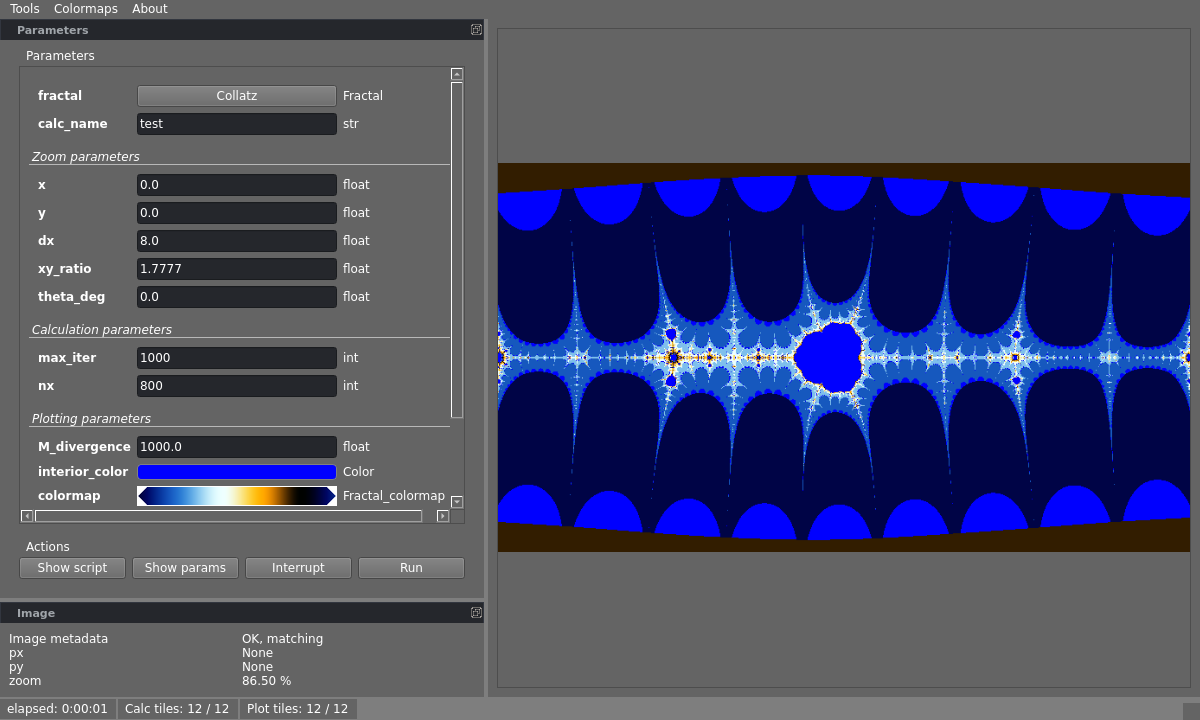Note
Click here to download the full example code
S04 - Collatz explorer - Standard precision
This is a simple template to explore the Collatz set with a GUI (example of “low-level API” for GUI implementation). Resolution limited to approx 1.e-13 due to double (float64) precision
Reference:
fractalshades.models.Collatz

import os
import numpy as np
import fractalshades as fs
import fractalshades.models as fsm
import fractalshades.settings as settings
import fractalshades.colors
import fractalshades.gui as fsgui
from fractalshades.gui.guimodel import Fractal_GUI
from fractalshades.postproc import (
Postproc_batch,
Raw_pp,
)
from fractalshades.colors.layers import (
Color_layer,
Bool_layer,
)
def plot(plot_dir):
"""
Example of "low-level API" for GUI implementation
"""
calc_name = 'test'
x = 0.0
y = 0.0
dx = 8.
xy_ratio = 1.7777
theta_deg = 0.
max_iter = 1000
nx = 800
M_divergence = 1000.0
interior_color = (0.0, 0.0, 1.0)
colormap = fs.colors.cmap_register["classic"]
zmin = 0.0
zmax = 0.5
# Set to True to enable multi-processing
settings.enable_multithreading = True
# Set to True in case RAM issue (Memory error)
settings.optimize_RAM = False
settings.inspect_calc = True
directory = plot_dir
fractal = fsm.Collatz(directory)
def func(
fractal: fsm.Mandelbrot=fractal,
calc_name: str= calc_name,
_1: fsgui.separator="Zoom parameters",
x: float= x,
y: float= y,
dx: float= dx,
xy_ratio: float=xy_ratio,
theta_deg: float=theta_deg,
_2: fsgui.separator="Calculation parameters",
max_iter: int=max_iter,
nx: int=nx,
_3: fsgui.separator="Plotting parameters",
M_divergence: float=M_divergence,
interior_color: fs.colors.Color=interior_color,
colormap: fs.colors.Fractal_colormap=colormap,
zmin: float=zmin,
zmax: float=zmax,
zshift: float=0.0
):
fractal.zoom(x=x, y=y, dx=dx, nx=nx, xy_ratio=xy_ratio,
theta_deg=0., projection="cartesian")
fractal.base_calc(
calc_name=calc_name,
subset=None,
max_iter=max_iter,
M_divergence=M_divergence,
epsilon_stationnary=1.e-4,
)
pp = Postproc_batch(fractal, calc_name)
pp.add_postproc("n_iter", Raw_pp("stop_iter", func=None))
pp.add_postproc("interior", Raw_pp("stop_reason",
func=lambda x: x != 1))
plotter = fs.Fractal_plotter(pp)
plotter.add_layer(Bool_layer("interior", output=False))
plotter.add_layer(Color_layer(
"n_iter",
func=lambda x: np.log(x + 10.),
colormap=colormap,
probes_z=[zmin + zshift, zmax + zshift],
output=True))
plotter["n_iter"].set_mask(
plotter["interior"], mask_color=interior_color
)
plotter.plot()
# Renaming output to match expected from the Fractal GUI
layer = plotter["n_iter"]
file_name = "{}_{}".format(type(layer).__name__, layer.postname)
src_path = os.path.join(fractal.directory, file_name + ".png")
dest_path = os.path.join(fractal.directory, calc_name + ".png")
if os.path.isfile(dest_path):
os.unlink(dest_path)
os.link(src_path, dest_path)
gui = Fractal_GUI(func)
gui.connect_image(image_param="calc_name")
gui.connect_mouse(x="x", y="y", dx="dx", xy_ratio="xy_ratio", dps=None)
gui.show()
if __name__ == "__main__":
# Some magic to get the directory for plotting: with a name that matches
# the file or a temporary dir if we are building the documentation
try:
realpath = os.path.realpath(__file__)
plot_dir = os.path.splitext(realpath)[0]
plot(plot_dir)
except NameError:
import tempfile
with tempfile.TemporaryDirectory() as plot_dir:
fs.utils.exec_no_output(plot, plot_dir)
Total running time of the script: ( 0 minutes 2.925 seconds)